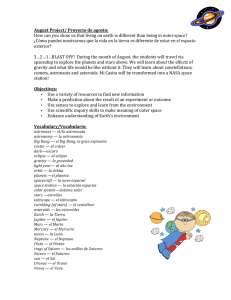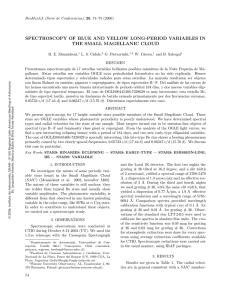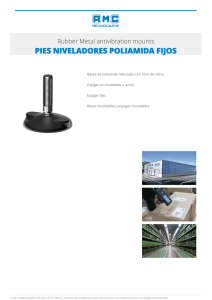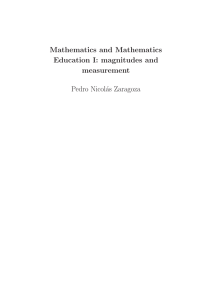hamc2 astrometry and photometry calibration and
Anuncio
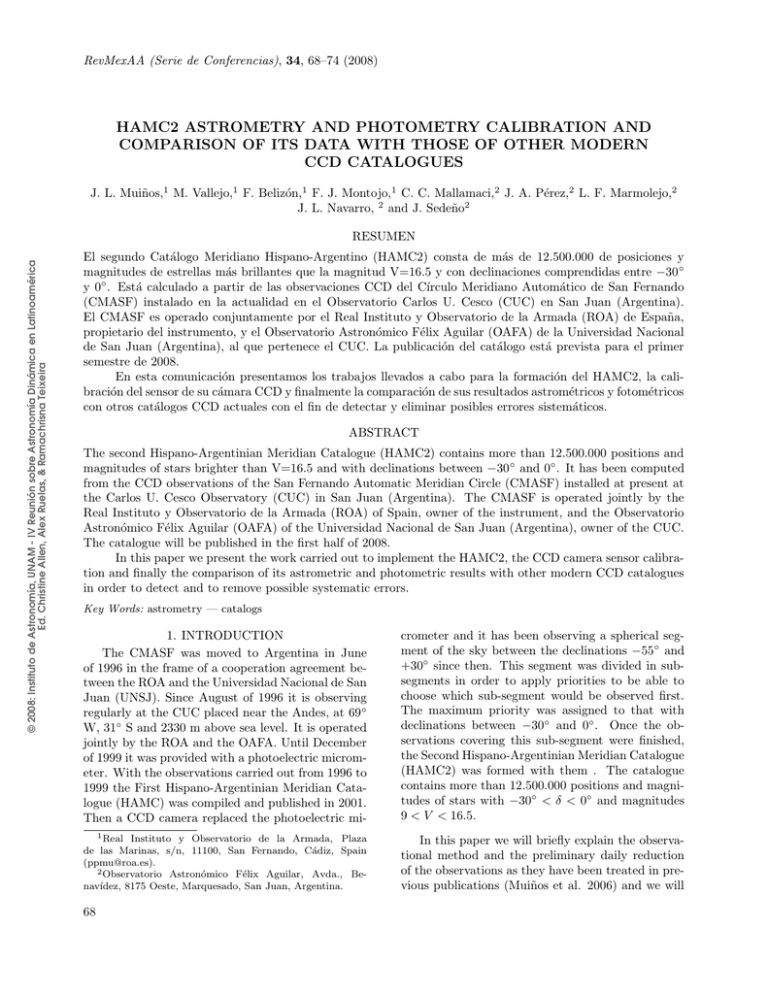
RevMexAA (Serie de Conferencias), 34, 68–74 (2008) HAMC2 ASTROMETRY AND PHOTOMETRY CALIBRATION AND COMPARISON OF ITS DATA WITH THOSE OF OTHER MODERN CCD CATALOGUES J. L. Muiños,1 M. Vallejo,1 F. Belizón,1 F. J. Montojo,1 C. C. Mallamaci,2 J. A. Pérez,2 L. F. Marmolejo,2 J. L. Navarro, 2 and J. Sedeño2 © 2008: Instituto de Astronomía, UNAM - IV Reunión sobre Astronomía Dinámica en Latinoamérica Ed. Christine Allen, Alex Ruelas, & Ramachrisna Teixeira RESUMEN El segundo Catálogo Meridiano Hispano-Argentino (HAMC2) consta de más de 12.500.000 de posiciones y magnitudes de estrellas más brillantes que la magnitud V=16.5 y con declinaciones comprendidas entre −30 ◦ y 0◦ . Está calculado a partir de las observaciones CCD del Cı́rculo Meridiano Automático de San Fernando (CMASF) instalado en la actualidad en el Observatorio Carlos U. Cesco (CUC) en San Juan (Argentina). El CMASF es operado conjuntamente por el Real Instituto y Observatorio de la Armada (ROA) de España, propietario del instrumento, y el Observatorio Astronómico Félix Aguilar (OAFA) de la Universidad Nacional de San Juan (Argentina), al que pertenece el CUC. La publicación del catálogo está prevista para el primer semestre de 2008. En esta comunicación presentamos los trabajos llevados a cabo para la formación del HAMC2, la calibración del sensor de su cámara CCD y finalmente la comparación de sus resultados astrométricos y fotométricos con otros catálogos CCD actuales con el fin de detectar y eliminar posibles errores sistemáticos. ABSTRACT The second Hispano-Argentinian Meridian Catalogue (HAMC2) contains more than 12.500.000 positions and magnitudes of stars brighter than V=16.5 and with declinations between −30 ◦ and 0◦ . It has been computed from the CCD observations of the San Fernando Automatic Meridian Circle (CMASF) installed at present at the Carlos U. Cesco Observatory (CUC) in San Juan (Argentina). The CMASF is operated jointly by the Real Instituto y Observatorio de la Armada (ROA) of Spain, owner of the instrument, and the Observatorio Astronómico Félix Aguilar (OAFA) of the Universidad Nacional de San Juan (Argentina), owner of the CUC. The catalogue will be published in the first half of 2008. In this paper we present the work carried out to implement the HAMC2, the CCD camera sensor calibration and finally the comparison of its astrometric and photometric results with other modern CCD catalogues in order to detect and to remove possible systematic errors. Key Words: astrometry — catalogs 1. INTRODUCTION The CMASF was moved to Argentina in June of 1996 in the frame of a cooperation agreement between the ROA and the Universidad Nacional de San Juan (UNSJ). Since August of 1996 it is observing regularly at the CUC placed near the Andes, at 69◦ W, 31◦ S and 2330 m above sea level. It is operated jointly by the ROA and the OAFA. Until December of 1999 it was provided with a photoelectric micrometer. With the observations carried out from 1996 to 1999 the First Hispano-Argentinian Meridian Catalogue (HAMC) was compiled and published in 2001. Then a CCD camera replaced the photoelectric mi- crometer and it has been observing a spherical segment of the sky between the declinations −55◦ and +30◦ since then. This segment was divided in subsegments in order to apply priorities to be able to choose which sub-segment would be observed first. The maximum priority was assigned to that with declinations between −30◦ and 0◦ . Once the observations covering this sub-segment were finished, the Second Hispano-Argentinian Meridian Catalogue (HAMC2) was formed with them . The catalogue contains more than 12.500.000 positions and magnitudes of stars with −30◦ < δ < 0◦ and magnitudes 9 < V < 16.5. 1 Real Instituto y Observatorio de la Armada, Plaza de las Marinas, s/n, 11100, San Fernando, Cádiz, Spain ([email protected]). 2 Observatorio Astronómico Félix Aguilar, Avda., Benavı́dez, 8175 Oeste, Marquesado, San Juan, Argentina. In this paper we will briefly explain the observational method and the preliminary daily reduction of the observations as they have been treated in previous publications (Muiños et al. 2006) and we will 68 HAMC2 ASTROMETRY AND PHOTOMETRY describe in detail the process of the catalogue formation. We will present especially the calibration of the CCD sensor and finally we will compare the astrometric results published in HAMC2 with those in CMC14 and UCAC2, and the photometric ones with those in 2MASS and DENIS. © 2008: Instituto de Astronomía, UNAM - IV Reunión sobre Astronomía Dinámica en Latinoamérica Ed. Christine Allen, Alex Ruelas, & Ramachrisna Teixeira 2. ROBOTIC OBSERVATIONS The CMASF observes in drift-scan mode (Stone 1993). In this mode once the telescope is pointed to the required declination and fixed, the stars pass through the CCD sensor following a path parallel to the equator. So if the shutter is open and the rate of line readout of the camera is synchronized with the transit speed of the stars we get as result of the observation the image of a strip of sky with dimensions depending in declination on the size of the CCD chip, and in right ascension on the time that the shutter was open. In the CMASF the dimension are 18 arc minutes in declination and between 20 minutes and 2.75 hours in right ascension. To optimize the necessary time to observe completely a sub-segment of the sky the whole segment is divided in strips of 10 arc minutes in declination and the settings of the telescope are aimed at the center of that strips. This method of setting is not arbitrary; it has been implemented to get an overlapped band of 8 arc-minutes between every strip and the two immediately adjoinning ones, the upper and lower ones, in declination. These overlapping bands will be used a posteriori to remove the influence of atmospherical fluctuations occuring while the strips were observed. The CMASF observations are completely robotic; the observer on duty only has to do a minimum of daily jobs before giving “green light” to the observation: perform the preliminary reduction of the observation of the previous night, save the files with useful data, prepare a list with the strips to observe the following night and check that all is working properly. All these jobs are made generally in remote mode. Once the instrument has got green light the robotic system remains in charge of the observation. It goes into a loop checking every 30 seconds the Sun altitude over the horizon. When the altitude is 2◦ over the horizon the system opens the dome (if the atmospherical conditions allow it) to equalize the dome temperature with the outside one. Afterward, when the Sun is 9◦ below the horizon, it begins to observe the set of sky strips selected for the night and continues until the Sun is 9◦ below the horizon before dawn. Then it stops the observation 69 and copies the observed images to another computer where the preliminary reduction will be carried out. If the atmospherical conditions were adverse during the observation the system stops it, closes the dome and waits for conditions to be OK; then it opens the dome and restarts the observation, selecting a convenient strip. Once all the strips are copied to the calculus-PC a digital image processor program starts automatically and computes the photocenter positions and intensities of all the images detected in every strip, jointly with other useful information about its ellipticity and about the sky background. 3. DAILY PRELIMINARY REDUCTION In the morning following the observation, the observer insitu or in remote mode must proceed to the preliminary reduction of the observed strips. The process is completely automatic, the observer only has to run interactive applications. The first of them checks that all the files are present and the data are in the correct format. Then another application does the actual reductions. The reduction consists in referring the observed positions and magnitudes to the ICRF using the Tycho2 catalogue (Høg et al. 2000). 3.1. Astrometric reduction The astrometric reduction is carried out in a similar way to that used to reduce the astronomical photographic plates. Firstly, taking into account the right ascension and declination limits of the strip, the Tycho2 catalogue is explored to select the stars that will be present in the strip. Then their positions are converted from mean to apparent for the observation date and with these positions and the ones of the strip center standard coordinates are computed. As a first step, the Tycho2 stars are identified using a 200 pixel-radius. With the differences (observed minus standard in x and y coordinates) two equations are formed for each star: xo − x T = a 1 + b1 · x o yo − y T = a 2 + b 2 · y o . (1) The system is solved by the least squares method to obtain a1 and a2 , the offsets in right ascension and declination of the center of the strip, and b1 and b2 , the corrections to the nominal scales in x and y respectively. These parameters are used to correct the x and y of all the stars in the strips and then a new identification of Tycho2 stars is carried out, now with a 20 pixel radius. Again with the differences 70 MUIÑOS ET AL. observed minus standard a system of equations is formed, this time with six parameters: xo − x T = a 1 + b1 · x o + c 1 · yo yo − y T = a 2 + b 2 · y o + c 2 · x o . (2) © 2008: Instituto de Astronomía, UNAM - IV Reunión sobre Astronomía Dinámica en Latinoamérica Ed. Christine Allen, Alex Ruelas, & Ramachrisna Teixeira Once the system is solved, the positions of all the stars in the strip are corrected using the six parameters. The cross-parameter c1 and c2 correct for the CCD chip rotation with respect to the equator and for differential refraction. 3.2. Photometric reduction The observed visual magnitudes of all the stars in every observed strip are computed as a function of the intensity I of the images by the classical formula m = m0 − 2.5 · log I (3) A Gaussian type correction ∆m = A − B · e2· (m−m0 ) C2 , (4) is applied to all the magnitudes fainter than V=10 so as to take into account the non-linear response of the CCD chip with faint illumination. A, B and C were calculated by comparing the observed magnitudes with the visual ones published in the Astrometric Calibration Regions (ACR) (Stone et al. 1999). To refer the HAMC2 magnitudes to the V magnitudes of the Tycho2 catalogue, the observed magnitudes of the Tycho2 stars present in every strip are compared with those of the catalogue and one equation, mT = m o + a (5) is formed for every identified star. Solving the system the value of a is determined. a is a parameter involving the transmission factor of the telescope optics and the atmospheric transparency at the time of observation. 4. CATALOGUE FORMATION Once the required sky segment is completely covered with observed strips the catalogue of that zone may be compiled. Firstly it is necessary to remove from every strip the influence of the atmospheric conditions during the night of the observation. Plotting the right ascension and declination O–C differences of Tycho2 stars observed in the strips it is easy to appreciate that these differences are not regularly spread around the zero point. On the contrary, they present systematic paths some times over and some times below the zero point, with periods of about 1000 pixels. Those systematic differences are connected with fluctuations in the atmospheric layers during the time of the observation of the strips (Benevides-Soares, Teixeira, & Réquième 1993). To remove the effect of these atmospheric fluctuations mainly two methods are employed: the sub-catalogue method and the partial overlapping method. 4.1. The sub-catalogue method To use this method (Viateau et al. 1999) every strip is observed a number of times and every observation is referred to the ICRF using a catalogue such as Hipparcos or Tycho2. Then a sub-catalogue is formed with the average of the right ascension and declination of the stars common to all the observations of the strip. Using this sub-catalogue as reference all the observations are re-reduced and a new sub-catalogue is formed. The process it iterated until agreement between the results is obtained. Generally it is necessary to iterate at least 10 times. 4.2. The partial overlapping method The partial overlapping method was implemented by D. Evans (Evans, Irwing, & Helmer 2002). The main advantage of the method is that it requires fewer observations for a particular zone than the subcatalogue one. The method takes advantage of the the overlapped bands among every strip and the upper and lower ones in the automatic selection described in § 2. Generally, the Tycho2 stars in those bands are not numerous enough to compute calibration functions in right ascension and declination so as to eliminate atmospheric fluctuations. To obtain a sufficient number of Tycho2 stars a couple of transference functions are determined, one for each coordinate, using all the stars in this band common to both strips. Using these transference functions all the Tycho2 stars in the upper strip are passed onto the primitive one. Then the process is applied to the second upper strip with respect to the upper one, and by successively applying the two set of transference functions the Tycho2 starting coordinates of the second upper strip are passed onto the primitive. The process is applied for the third upper strip with respect to the second one, and its Tycho2 stars are passed to the primitive one by application of three set of transference functions. The same procedure is applied to the the three consecutive lower strips (see Figure 1). In this way we obtain a sufficient number of Tycho2 stars to compute two calibration functions, one 71 © 2008: Instituto de Astronomía, UNAM - IV Reunión sobre Astronomía Dinámica en Latinoamérica Ed. Christine Allen, Alex Ruelas, & Ramachrisna Teixeira HAMC2 ASTROMETRY AND PHOTOMETRY Fig. 1. Example of fluctuation correction using the partial overlapping method. (a) shows the right ascension and declination O–C’s of all the stars in one strip. (b) shows the O–C’s of the Tycho2 stars of the same strip jointly with those of the three upper and lower adjacent strips, once the transference functions have been applied. The similarity between the shapes of Figures (a) and (b) should be noted. Applying cubic splines to the spread points in (b) the calibration functions are determined. (c) shows the final O–C’s of all the stars of the strip considered in (a) after the calibration functions computed from (b) have been applied. MUIÑOS ET AL. 0,10 Data: COMPHA2STO_C Model: Gauss (HAMC2-Stone) α" cos δ for the right ascensions and one for the declinations, in order to remove the fluctuations in both coordinates for all the stars in the strip. The method is not easy to apply but it greatly reduces the number of observations necessary to produce a catalogue of a sky region. This method has been used in computing the HAMC2. The application of the method is carried out by a program that computes and corrects the atmospheric fluctuation of all the observed strips. The execution of the program may take several days, depending on the computer speed. The final result of the process is a file with the equatorial coordinates and magnitudes of all the stars detected in every observed strip. y0 xc w A 0.00063 ±0.00475 15.97871 ±1.14651 2.16196 ±1.41486 -0.1849±0.17767 0,00 -0,05 11 12 13 14 15 16 Magnitud 0,15 Data: COMPHA2STO_D Model: Gauss 4.3. Formation of the provisional catalogue The next step is to analyze this file to detect and remove from it the star images that were cut by the upper or lower border of the strip, because those images will be circular segments instead of full circles so the detected photocenter of the image will not be in coincidence with the real center of the star image. This produces a systematic error in its declination and magnitude. There is no effect in right ascension as the images are symmetrical with respect to a vertical center line. As the strips are processed and sorted by date of observations, the file produced in removing fluctuations is not sorted by increasing rights ascension. So it is necessary to sort it by right ascension to facilitate the identification of stars with more than one observation, to adopt an average for the epoch, coordinates and magnitude as the catalogue epoch, coordinates and magnitude. The zones close to major planets are avoided automatically by the program selecting the strips to be observed every night, but in the strips covering the zodiacal zone, Neptune, Pluto, satellites and minor planets have been observed along with stars. So it is necessary to identify these planets and satellites and to remove their lines from the output file. To do this, data bases with orbital elements for these bodies are explored to determine if any non stellar object would be present in every strip. Then its equatorial positions for the observation dates are computed and compared with those of the images detected in the strips. If there is a coincidence inside a radius of 100 the object is flagged as possible Solar System object. Afterwards the flagged lines are checked, and if they have been observed only once they are removed from the file and filed separately to be analyzed a posteriori in order to publish the corresponding observed Solar System object positions and magnitudes. Chi^2 = 0.00017 R^2 = 0.7908 0,05 -0,10 10 0,10 (HAMC2-Stone2) δ" © 2008: Instituto de Astronomía, UNAM - IV Reunión sobre Astronomía Dinámica en Latinoamérica Ed. Christine Allen, Alex Ruelas, & Ramachrisna Teixeira 72 Chi^2 = 0.00003 R^2 = 0.98796 y0 xc w A 0,05 -0.00446 15.32731 2.10616 -0.27175 ±0.00241 ±0.09203 ±0.18948 ±0.02595 0,00 -0,05 -0,10 -0,15 10 11 12 13 14 15 16 Magnitud Fig. 2. Systematic differences HAMC2-ACR in R.A. and Dec. and Gaussian fits. 4.4. Searching and removing systematic errors Once the stars with several positions have been processed and the Solar System objects have been removed a draft catalogue is obtained. Then it is time to investigate if there are any systematic errors present. To do this the ACR has been used as master catalogue for both coordinates. In Figure 2 we have plotted the differences in right ascension and declination in the sense HAMC2-ACR. It easy to note clear systematic trends as function of the magnitude for stars fainter than V = 12.5 in both coordinates. The explanation for these systematic errors could be problems in the charge transfer efficiency, in the line readout for the right ascensions, and in the pixel to pixel readout register for the declinations. The magnitudes have not been considered in this step because they had been corrected previously as was explained in § 3.2. Also shown in the figure are the fits of these differences with a couple of Gaussian curves of the type. ∆y = y0 − (m−m0 )2 A √ e2· w2 . w 2π (6) HAMC2 ASTROMETRY AND PHOTOMETRY 0,15 0,10 • HAMC2-CMC14 * HAMC2-UCAC2 • R.A. * Dec. + Mag. 0,05 ∆α cos δ (seg. arco) 0,10 ε" 0,05 9 10 11 12 13 14 15 16 0,00 -0,05 -0,10 17 9 10 11 Magnitude 12 13 14 15 16 14 15 16 Magnitud 0,10 Fig. 3. Mean square errors of the HAMC2 as a function of magnitude. • HAMC2-CMC14 * HAMC2-UCAC2 0,05 The correlation between the fits function and the differences is very good, so the values of y0 , A, w and m0 deduced from them have been used to remove the systematic errors in both coordinates. 5. THE HAMC2 CATALOGUE The second Hispano-Argentinian Meridian Catalogue has been computed following the methods described in previous paragraphs. It contains 12.560.153 positions and magnitudes of stars with declinations between −30◦ and 0◦ and magnitudes 9 < V < 16. The internal mean error for a catalogue position in both coordinates is below 50 milliarcseconds for stars brighter than 14 V, increasing for fainter stars. For the magnitudes the mean error is below 0m .1 also for stars brighter than 14 V. The catalogue will be published in the second half of 2008. In Figure 3 are plotted the mean square errors in right ascension, declination and magnitude of the HAMC2 as a function of magnitude. 6. COMPARISON OF THE HAMC2 WITH OTHER MODERN ASTROMETRIC AND PHOTOMETRIC CATALOGUES Systematic errors in both coordinates and magnitudes of the HAMC2 were detected for faint stars. These errors were very probably produced by the electronic features of the CCD sensor and have been removed by Gaussian correction, as was explained in §§ 4.4 and 3.2 respectively. To check if after the Gaussian corrections the HAMC2 positions and magnitudes are free of systematic errors, comparisons has been made with the CMC14 and UCAC2 catalogues for the astrometry and with the 2MASS and DENIS ones for the photometry. ∆δ (seg. arco) © 2008: Instituto de Astronomía, UNAM - IV Reunión sobre Astronomía Dinámica en Latinoamérica Ed. Christine Allen, Alex Ruelas, & Ramachrisna Teixeira 0,00 73 0,00 -0,05 -0,10 9 10 11 12 13 Magnitud Fig. 4. Differences in right ascension and declination between HAMC2, CMC14 and UCAC2. In Figure 4 are shown the differences in right ascension and declination between the catalogues HAMC2, CMC14 and UCAC2. A small systematic effect is still present in declination. It will be investigated and removed before publication of the catalogue. Figures 5 and 6 show the differences in magnitudes between the HAMC2 photometry and that of the 2MASS catalogue and the data base DENIS. The bands J and I respectively have been used because they are the closest ones to the V band published in the HAMC2. As both catalogues are huge, only three zones of each have been used for the comparison centered on −5◦ , −15◦ and −25◦ . It is possible to observe constant differences V − J and V − I in both graphs. The agreement is very good with 2MASS. With DENIS it is worse for stars brighter than V =9 and fainter than V =15. 7. FINAL CONSIDERATIONS The HAMC2 has reached a precision below 50 milli-arseconds in both coordinates for stars brighter 74 MUIÑOS ET AL. 2,5 A new CCD camera with a bigger and more sensitive sensor will be installed in the CMASF in the summer of 2008. Then the telescope will be able to start new observational programs. The Management Committee of the CMASF will consider the possibility to observe programs requested by any member of the Latin American scientific community. 2,0 1,5 ∆m 1,0 • - 5º + -15º * -25º © 2008: Instituto de Astronomía, UNAM - IV Reunión sobre Astronomía Dinámica en Latinoamérica Ed. Christine Allen, Alex Ruelas, & Ramachrisna Teixeira 0,5 0,0 9 10 11 12 13 14 15 16 Magnitud(V) Fig. 5. Differences in magnitude HAMC2(V)-2MASS(J). 2,5 • - 5º + -15º * -25º 2,0 1,5 ∆m 1,0 We are grateful for the help supplied to the CMASF in Argentina by Leif Helmer from the Copenhaguen University Observatory and Dafydd Evans and Mike Irwin from the Institute of Astronomy of Cambridge, for kindly and generously providing part of the automatic observations and catalogue formation software. We wish to thank the Estado Mayor de la Armada of Spain through the ROA and the Universidad Nacional de San Juan of Argentina through the OAFA for their cooperation in the project. The financial support of the operation of the CMASF in Argentina has been provided by the Ministerio de Educación y Ciencia of Spain through the Acciones Complementarias AYA2004-23240-E y AYA2005-24974-E. 0,5 REFERENCES 0,0 9 10 11 12 13 14 15 16 Magnitud(V) Fig. 6. Differences in magnitude HAMC2(V)-DENIS(I). than V=14 as expected. The precision in magnitude for those stars is also very good. After removing the systematic errors produced by the CCD sensor the results agree closely with those of other modern astrometric and photometric catalogues. Unfortunately a failure of the CCD camera of the CMSASF happened in May 2007 which made impossible to finish the observations to cover the sky segment with declination between −55◦ and +30◦ as was planned. Benevides-Soares, P., Teixeira, R., & Réquième, Y. 1993, A&A, 278, 293 Carlsberg Consortium 2005, Carlsberg Meridian Catalogue La Palma, No. 14 (Copenhagen University Observatory, Institute of Astronomy of Cambridge, Real Instituto y Observatorio de la Armada (San Fernando: Inst. Obs. Marina) Evans, D., Irwing, M., & Helmer, L. 2002, A&A, 395, 347 Høg, E., et al. 2000, A&A, 355, L27 Muiños, J. L., et al. 2006, RevMexAA (SC), 25, 47 Stone, R. C. 1993, in IAU Symp. 156, Developments in Astrometry and their Impact on Astrophysics and Geodynamics, ed. I. I. Mueller & B. Kolaczek (Dordrecht: Kluwer), 65 Stone, R. C., et al. 1999, AJ, 118, 2884 Viateau, B., et al. 1999, A&A, 134, 173
